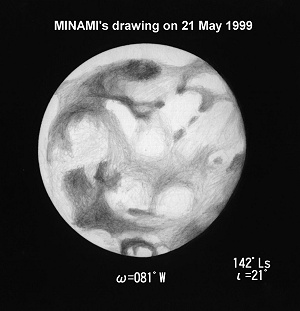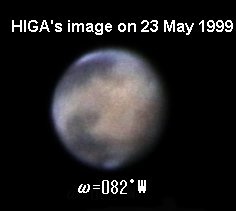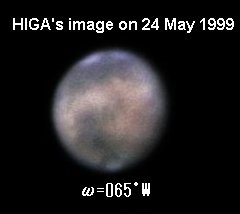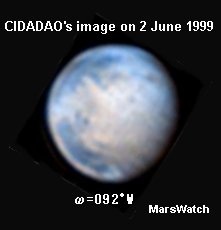

On 26 Mar (115°Ls) 1999, Don PARKER (DPk) in Florida showed a surface of LCM=133°W (see #215 p2463) where the Tharsis ridges were shown up white: The local Martian time (LMT) of Ascraeus Mons was then about 15h20m LMT.
On the images by DPk on 2 Apr at LCM=063°W they were not so definite, but DPk's images on 3 Apr (119°Ls, the apparent diameter=14.2", the phase angle=17°) at LCM=058°W & 071°W depicted definitely Ascraeus Mons as a dark spot. Its LMT was 10h20m in the morning. (Our improvised method of knowing LMT is as follows: The position of Ascraeus Mons is Longitude=105°W. Now let LCM=058°W, and then the summit is separated from the CM by 47°. Taking the phase angle=17° into account, we know the separation is 64°from the dawn line. 64/15 implies 4.3 hours and hence we obtain 6h+4.3h=10.3h as the local time of the summit. A raw employment of the phase angle is not very correct, but we consider it is quite appropriate.) The images also show Pavonis Mons as well as Arsia Mons.
We observers in Japan began to get a good sight of the morning Tharsis region from 13 Apr ~14 Apr 1999 (124°Ls): HIGA (Hg)'s CCD-Video images on 14 Apr (124°Ls, the apparent diameter=15.4", the phase angle=09°) at 15:26 GMT (LCM=092°W) prove the Tharsis three summits as shadowy spots. Olympus Mons was also seen. On 14 Apr, Hg also obtained the images at LCM=102°W, 112°W, 122°W and 131°W. At LCM=102°W, a white misty area followed Ascraeus Mons. The present writer (Mn) watched at LCM=115°W on the day, and detected the dark Tharsis ridge as well as the following white area. Olympus Mons was also visible. Ascraeus Mons was at 13h20m LMT.
The images of Hg on 15 Apr and 16 Apr were rather unstable, but Hg shot on 16 Apr (125°Ls) at LCM=065°W, 075°W and 084°W. Mn observed on 15 and 16 Apr nineteen times, but mostly seeing was poor. Mn's observation on 16 Apr at LCM=078°W showed a conspicuous white patch near (maybe following) Ascraeus Mons at 10h40m LMT. Alba was also whitish.
Next chance came in mid-May in Japan: At Fukui, Mn observed the area of Arsia Mons as a shadowy spot on 16 May (140°Ls) at LCM=108°W: Olympus Mons was also evident with an outer ring. Ascraeus Mons was obscure but already at 13h00m LMT. Next at LCM=118°W Arsia Mons was still dark. We saw similarly on 17 May; but the results from 20 May were much fruitful:
Hg's image on 20 May (142°Ls, the phase angle=21°) at LCM=096°W clearly shows the three dark dots.
 On 21 May (142°Ls, the apparent diameter=15.3", the phase angle=21°), Mn observed seven times and, at LCM=081°W Mn saw clearly the dark ridge spots and Olympus Mons (as cited here). Ascraeus Mons was at 9h00m LMT. It was seen dark also at LCM=091°W.
On 21 May (142°Ls, the apparent diameter=15.3", the phase angle=21°), Mn observed seven times and, at LCM=081°W Mn saw clearly the dark ridge spots and Olympus Mons (as cited here). Ascraeus Mons was at 9h00m LMT. It was seen dark also at LCM=091°W.
On 22 May (142°Ls), Mn caught early at LCM=053°W a few of dark spots. Possibly it may be Pavonis Mons, but if it is Ascraeus Mons it was at 07h00m LMT. At LCM=062°W, Olympus Mons was inside following the dark Tharsis ridges. Arsia's shadow was quite visible until LCM=101°W.
On 23 May and 24 May, Hg produced good images. On 23 May (143°Ls, the apparent diameter=15.1", the phase angle=23°) Hg recorded at LCM=053°W, 063°W, 073°W, 082°W, and 094°W: At LCM=053°W, Ascraeus Mons is already spotted dark, and at LCM=063°W Olympus Mons looks to follow the dark Tharsis ridges. At LCM=073°W, the three dots are definite. A white cloud patch follows Ascraeus Mons. The image at LCM=082°W is good, and they are more inside. The white cloud is thicker near Pavonis Mons. Finally at LCM=094°W, Arsia Mons is quite dark evident.


As to the question how far the dark spots move into the inside within a day, we have a record that the three spots were faintly seen at LCM=147°W on 13 May (138°Ls, the phase angle=15°) when Ascraeus Mons was at 14h00m LMT. Already the white roundish clouds associated with Ascraeus Mons and Olympus Mons were present.
 As the month of June came in, the region turned to face to Europe. The Internet MarsWatch shows some images made by António José CIDADÃO in Portugal by the use of a 25cm LX200 SCT equipped with an ST-5C on 2 June (148°Ls) at LCM=092°W and 110°W where the three Tharsis ridges as well as Olympus Mons are shown. His images on 5 June (150°Ls) at LCM=071°W and LCM=089°W also show the aspects. CIDADÃO's earlier images on 2 May (133°Ls) at LCM=080°W~105°W seem to prove several spots, but it is rather difficult to tell out them from other ghosts.
As the month of June came in, the region turned to face to Europe. The Internet MarsWatch shows some images made by António José CIDADÃO in Portugal by the use of a 25cm LX200 SCT equipped with an ST-5C on 2 June (148°Ls) at LCM=092°W and 110°W where the three Tharsis ridges as well as Olympus Mons are shown. His images on 5 June (150°Ls) at LCM=071°W and LCM=089°W also show the aspects. CIDADÃO's earlier images on 2 May (133°Ls) at LCM=080°W~105°W seem to prove several spots, but it is rather difficult to tell out them from other ghosts.
Then in America, PARKER (DPk) produced excellent images of the morning Tharsis ridges and Olympus Mons on 10 June and 14 June: DPk's images on 10 June (152°Ls, the apparent diameter=13.4", the phase angle=32°) at LCM=107°W and 116°W clearly prove Tharsis Montes existing as dark spots and Olympus Mons together with its outer ring. The white cloud is thicker following Pavonis Mons. At LCM=116°W, the summit of Ascraeus Mons was definitely dark and its LMT was at 10h30m LMT.
 The following images taken on 14 June (154°Ls) at LCM=076°W and 081°W are also superb where Arsia Mons and Ascraeus Mons are big dark spots. These images also show an interesting detail near at Fortuna Fossae (094°W, 03°N) around which a white mist thickly expands. The LMT was about 10h00m. The mist was less thick on the preceding day 10 June at 12h45m LMT. A similar, but weaker image of the white mist around Fortuna Fossae (may be a shadowy core) was obtained by the HST on 30 Mar 1997 (097°Ls). As well it was shot later by the MGS/MOC on 21 Aug 1997 (167°Ls)(see the image cited in CMO #196 p2178). The place contains a slow slope but is rather a large open plain with several fossae.
The following images taken on 14 June (154°Ls) at LCM=076°W and 081°W are also superb where Arsia Mons and Ascraeus Mons are big dark spots. These images also show an interesting detail near at Fortuna Fossae (094°W, 03°N) around which a white mist thickly expands. The LMT was about 10h00m. The mist was less thick on the preceding day 10 June at 12h45m LMT. A similar, but weaker image of the white mist around Fortuna Fossae (may be a shadowy core) was obtained by the HST on 30 Mar 1997 (097°Ls). As well it was shot later by the MGS/MOC on 21 Aug 1997 (167°Ls)(see the image cited in CMO #196 p2178). The place contains a slow slope but is rather a large open plain with several fossae.
This season we were able to watch the morning case of the region rather frequently under favourable apparent diameter. The summits of Montes remained free from a covering cloud at least up to 14:00 LMT. The following franks became of course to be thickly covered by white mists as they moved to the afternoon side. The mist patches over the valleys among the mountains appeared early in the morning however. In particular the whitish mist following Ascraeus Mons and Pavonis Mons were still conspicuous in the morning every day.
A problem remains to be solved how and when the orographic wave is to constitute the cloud covering the summit. We sometimes thought that any white roundish patch itself showed the position of the summit of Mons, but it was quite possible that the summit was slightly deviated from the white patch, and hence the mechanism and the season of the phenomenon should be more detailed. The ambivalence concerning the positioning of Nix Olympica frequently seen in the past must have been caused by the different rise and development of the afternoon cloud in different seasons.